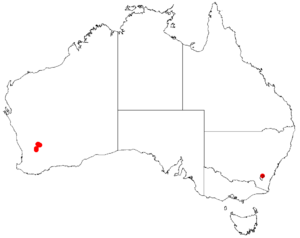Acacia merrickiae facts for kids
Quick facts for kids Acacia merrickiae |
|
|---|---|
| Conservation status | |
| Scientific classification | |
| Genus: |
Acacia
|
| Species: |
merrickiae
|
 |
|
| Occurrence data from AVH | |
Acacia merrickiae is a special kind of shrub. It belongs to the large Acacia family, also known as wattles. This plant is found only in a small part of southwestern Australia. This means it is endemic to that area.
Contents
About the Merrick's Wattle
This wattle is an open, spindly shrub. It usually grows to be about 2 to 4 meters (6 to 13 feet) tall. Its branches are smooth and covered in a fine white powder. You might also see small bumps where old leaf-like parts used to be.
What Does it Look Like?
Like most Acacia plants, Acacia merrickiae does not have true leaves. Instead, it has phyllodes. These are flattened leaf stems that look and act like leaves. The phyllodes are grey-green and feel a bit leathery. They are shaped like an oval or egg, often slightly curved inwards.
Each phyllode is about 1.5 to 3.5 centimeters long. They are also 7 to 15 millimeters wide. You can see a slightly raised line down the middle. These phyllodes also have that same fine white powdery coating.
Flowers and Seed Pods
This wattle blooms from April to June. It produces lovely yellow-cream flowers. These flowers grow in clusters called inflorescences. These clusters are found along a stem, about 10 to 40 millimeters long.
The flower-heads are round or slightly oval. They are about 5 to 6 millimeters across. Each flower-head holds between 45 and 65 light golden flowers.
After the flowers, thin, leathery seed pods form. These pods are long and narrow, up to 6 centimeters long. They are about 5 to 6 millimeters wide. The pods are also covered in a fine white powder. Inside, you'll find dull, dark brown seeds. They are oblong or oval-shaped, about 4 millimeters long.
How it Was Named
The Acacia merrickiae was first officially described in 1928. Two botanists, Joseph Maiden and William Blakely, did this work. Botanists are scientists who study plants. They wrote about it in a scientific paper.
Later, in 2003, another botanist named Leslie Pedley reclassified it. He called it Racosperma merrickiae. But in 2006, it was moved back to the Acacia group. This plant is part of a group called the Acacia microbotrya group. It looks similar to Acacia leptopetala and is closely related to Acacia meisneri.
Where it Grows
This special wattle grows only in a small part of Western Australia. It is found in the Wheatbelt region. This area is part of the IBRA Avon Wheatbelt zone.
It prefers to grow in certain types of soil. These include clay, sandy loam, and sandy soils. You can find it in areas around towns like Trayning, Kellerberrin, and Mukinbudin. It often grows as part of open woodland areas.


